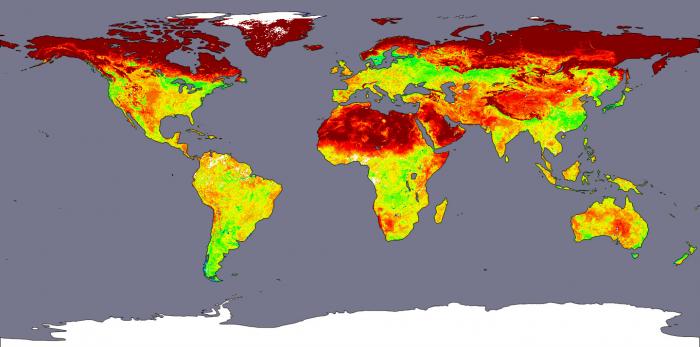Water plays a central role in many of the physical, chemical, and biological processes regulating the global environment. It is the working fluid of the atmospheric heat engine, sculptor of the land surface, and agent of chemical element cycling. Finally, it is necessary and limiting for life. The effects on society of global climate change are likely to be associated most heavily with changes in the regional availability of water.
The fluxes of energy and water from land surface to atmosphere are intimately linked and depend strongly upon the moisture state of the surface. The atmospheric processes responsible for supplying this moisture are themselves sensitive to the moisture-driven fluxes in a feedback process of variable importance to weather and climate depending upon such factors as latitude and season. Many important questions are unanswered relative to these fluxes, for example: What is the sensitivity of these fluxes to climate change? and What is the sensitivity of climate to change in the fluxes? Following are areas of interest to CGCS researchers.
Diagnostic Studies of the Hydrological Cycle-Detection of Climate Change
Natural spatial and time variability makes detection of climate change, particularly that of anthropogenic origin, difficult. Controversy abounds about the nature of the temperature signal that is commonly analyzed. Several other hydrometeorological variables like precipitation, streamflow, and atmospheric pressure may offer new windows for climate change detection. CGCS researchers are analyzing several of these records using the most powerful available statistical techniques and at the same time factoring in knowledge of natural inter-annual variabilities in the earth-atmosphere system.
It is clear that new approaches need to be taken in detecting precipitation trends at the continental scale. In any attempt to do so, one must be cognizant of the very large intra- and inter-annual variability of precipitation and the very close coupling that exists between precipitation and other geophysical and climatic parameters. Precipitation measurements are influenced by sampling elevation, distance from moisture sources, and nature of sampling instruments. Microclimate changes near urban areas have also been reported. Generally ignored are so-called teleconnections that exist at global scale, tying precipitation to oceanic forcing and moisture availability, and global atmospheric circulation.
CGCS researchers are working toward relating large-scale precipitation patterns (and their time changes) to changes in atmospheric circulation patterns and surface conditions. For example, ongoing studies of regions of West Africa and the Amazon Basin are focused on understanding the physical mechanisms and processes that define the response of the tropical atmosphere to deforestation. Such efforts help set the methodology for similar studies and highlight the interdependence of climatic variables across time and space.
Sensitivity of Climate to Land Surface Hydrology
Land surface hydrology parameterizations used in atmospheric general circulation models (GCMs) significantly affect the dynamics of the model climate, especially in terms of the fluctuations in near surface state variables. In order to assess the influences of various components in the land surface hydrology parameterization on the overlying atmospheric column and climate, CGCS researchers have developed a simplified climate model. The advantage of the simplified model is that it allows one to generate long climate simulations, collect more detailed diagnostics, and perform numerous controlled experiments with greater efficiency and effectiveness than would be feasible with a full three-dimensional GCM.
CGCS researchers are using the simple model to isolate the specific influence of different components in the respective parameterizations. The full GCM does not have this capability. Furthermore, long-term simulations are being generated to study the properties of convective rainfall under modified conditions introduced by alternate modeling and coupling strategies. Because this model includes coupling of the atmosphere and land surface, it provides a first order estimate of the sensitivity of climate to changes in the land surface hydrology. The new parameterizations are being implemented in full-scale GCMs to verify to the extent possible the conclusions from the simple model.
Dynamics of Coupled Land Surface and Atmosphere Systems
The study of nonlinear dynamics has its origins in climate systems, and the highly nonlinear behavior of atmospheric dynamics continues to be studied. Far less attention has been given to the nature of the land-atmosphere interactions. The nonlinear positive and negative feedbacks, operating across time and space, that control soil moisture are acknowledged by all, but understood largely in a qualitative sense. These nonlinear dynamics may be responsible for hydrologic extremes, like drought, that persist in time and space and occur in a manner that has escaped description with traditional methodologies.
Both the wet and the dry extremes of soil moisture show a temporal persistence far greater than the characteristic time of any element of the coupled soil/atmosphere system. The highly nonlinear nature of this coupling suggests the possibility of chaotic behavior, the understanding of which would help with drought forecasting. CGCS researchers are currently pursuing quantitative studies of the dynamics of soil moisture, for example by relating soil moisture distribution to the distribution of elevation, soil type, rainfall and vegetation dynamics. Such studies will facilitate the use of the readily available data sets describing topography for the purpose of defining the large-scale distribution of soil moisture.



